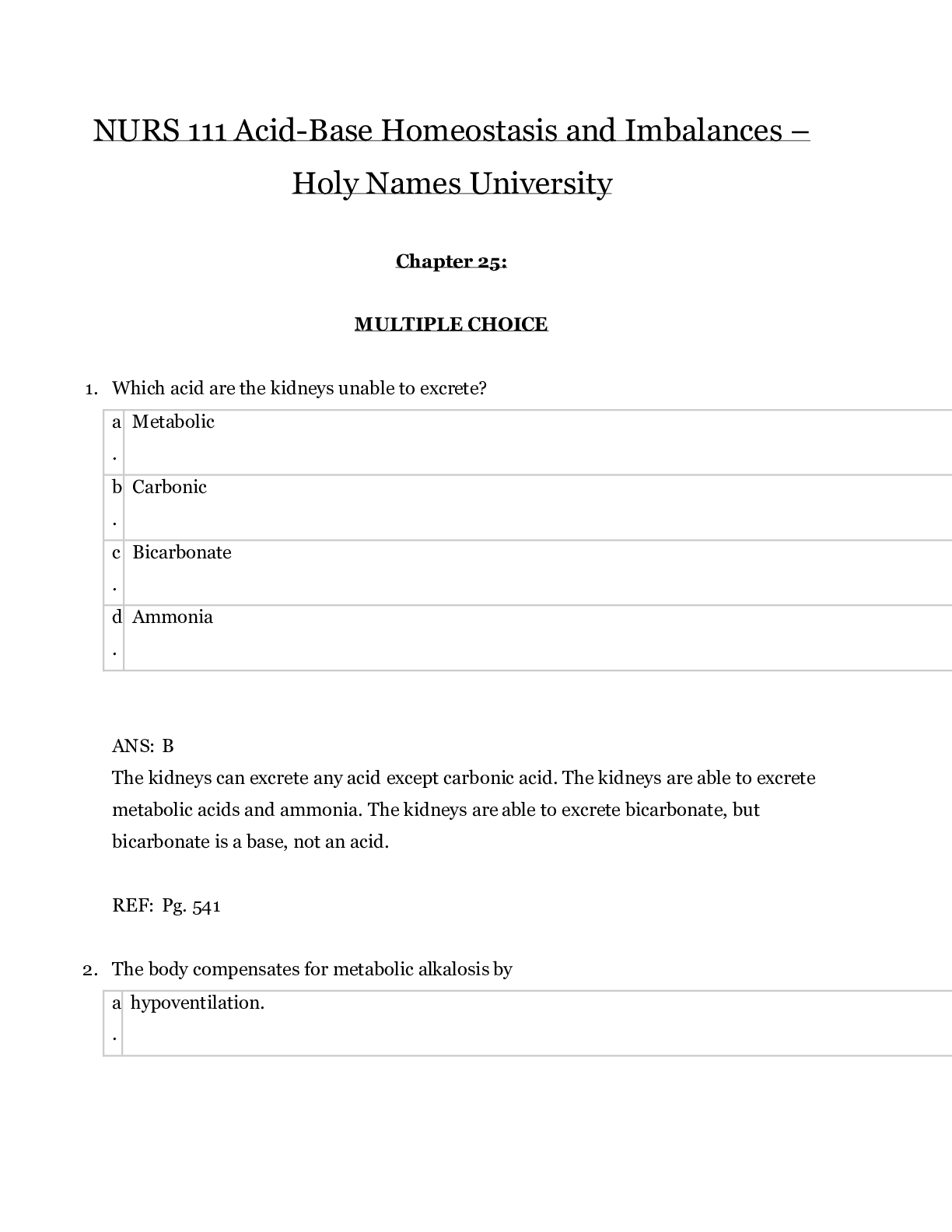*NURSING > EXAM > NURS 111 Fluid and Electrolyte Homeostasis and Imbalances - Holy Names University | NURS111 Fluid an (All)
NURS 111 Fluid and Electrolyte Homeostasis and Imbalances - Holy Names University | NURS111 Fluid and Electrolyte Homeostasis and Imbalances - 2020
Document Content and Description Below
NURS 111 Fluid and Electrolyte Homeostasis and Imbalances - Holy Names University Chapter 24: MULTIPLE CHOICE 1. Osmoreceptors located in the hypothalamus control the release of a. angiotens... in. b. atrial natriuretic peptide. c. aldosterone. d. vasopressin (antidiuretic hormone, ADH). 2. Decreased neuromuscular excitability is often the result of a. hypercalcemia and hypermagnesemia. b. hypomagnesemia and hyperkalemia. c. hypocalcemia and hypokalemia. d. hypernatremia and hypomagnesemia. 3. What is likely to lead to hyponatremia? a. Insufficient ADH secretion b. Excess aldosterone secretion c. Administration of intravenous normal saline d. Frequent nasogastric tube irrigation with water 4. An increase in the resting membrane potential (hyperpolarized) is associated with a. hypokalemia. b. hyperkalemia. c. hypocalcemia. d. hypercalcemia. 5. Abnormalities in intracellular regulation of enzyme activity and cellular production of ATP are associated with a. hyponatremia. b. hypocalcemia. c. hypophosphatemia. d. hypokalemia. 6. The fraction of total body water (TBW) volume contained in the intracellular space in adults is a. three-fourths. b. two-thirds. c. one-half. d. one-third. 7. What age group has a larger volume of extracellular fluid than intracellular fluid? a. Infants b. Adolescents c. Young adults d. Older adults 8. Clinical manifestations of severe symptomatic hypophosphatemia are caused by a. excess proteins. b. renal damage. c. deficiency of ATP. d. hypocalcemia. 9. A person who overuses magnesium-aluminum antacids for a long period of time is likely to develop a. hypokalemia. b. hyperkalemia. c. hypophosphatemia. d. hyperphosphatemia. 10. The electrolyte that has a higher concentration in the extracellular fluid than in the intracellular fluid is _____ ions. a. sodium b. phosphate c. magnesium d. potassium 11. A person who has hyperparathyroidism is likely to develop a. hypokalemia. b. hyperkalemia. c. hypocalcemia. d. hypercalcemia. 12. The inward-pulling force of particles in the vascular fluid is called _____ pressure. a. capillary hydrostatic b. interstitial osmotic c. capillary osmotic d. interstitial hydrostatic 13. How do clinical conditions that increase vascular permeability cause edema? a. Through altering the negative charge on the capillary basement membrane, which enables excessive fluid to accumulate in the interstitial compartment b. By causing movement of fluid from the vascular compartment into the intracellular compartment, which leads to cell swelling c. Through leakage of vascular fluid into the interstitial fluid, which increases interstitial fluid hydrostatic pressure d. By allowing plasma proteins to leak into the interstitial fluid, which draws in excess fluid by increasing the interstitial fluid osmotic pressure 14. Which alterations can lead to edema? a. Decreased capillary hydrostatic pressure b. Increased capillary colloid osmotic pressure c. Decreased lymphatic flow d. Decreased capillary membrane permeability 15. The process responsible for distribution of fluid between the interstitial and intracellular compartments is a. filtration. b. osmosis. c. active transport. d. diffusion. 16. Which electrolyte imbalances cause increased neuromuscular excitability? a. Hypokalemia and hyperphosphatemia b. Hyperkalemia and hypophosphatemia c. Hypocalcemia and hypomagnesemia d. Hypercalcemia and hypermagnesemia 17. Excessive antidiuretic hormone (ADH) secretion can cause _____ concentration. a. increased serum sodium b. decreased serum sodium c. increased serum potassium d. decreased serum potassium 18. Causes of hypomagnesemia include a. hyperphosphatemia. b. chronic alcoholism. c. oliguric renal failure. d. clinical dehydration. 19. Signs and symptoms of clinical dehydration include a. decreased urine output. b. increased skin turgor. c. increased blood pressure. d. decreased heart rate. 20. Hypernatremia may be caused by a. decreased aldosterone secretion. b. decreased antidiuretic hormone secretion. c. compulsive water drinking. d. excessive dietary potassium. 21. Clinical manifestations of hyponatremia include a. weak pulse, low blood pressure, and increased heart rate. b. thirst, dry mucous membranes, and diarrhea. c. confusion, lethargy, coma, and perhaps seizures. d. cardiac dysrhythmias, paresthesias, and muscle weakness. 22. Clinical manifestations of extracellular fluid volume deficit include a. weak pulse, low blood pressure, and increased heart rate. b. thirst, dry mucous membranes, and diarrhea. c. confusion, lethargy, coma, and perhaps seizures. d. cardiac dysrhythmias, paresthesias, and muscle weakness. 23. The imbalance that occurs with oliguric renal failure is a. metabolic alkalosis. b. hyperkalemia. c. hypokalemia. d. hypophosphatemia. 24. A known cause of hypokalemia is a. oliguric renal failure. b. pancreatitis. c. insulin overdose. d. hyperparathyroidism. 25. Effects of hypernatremia on the central nervous system typically include a. confusion. b. excitation. c. insomnia. d. hallucinations. 26. Total body water in older adults is a. increased due to decreased adipose tissue and decreased bone mass. b. increased due to decreased renal function and hormonal fluctuations. c. decreased due to increased adipose tissue and decreased muscle mass. d. decreased due to renal changes that cause diuresis with sodium excretion. 27. Clinical manifestations of moderate to severe hypokalemia include a. muscle spasms and rapid respirations. b. muscle weakness and cardiac dysrhythmias. c. confusion and irritability. d. vomiting and diarrhea. 28. Signs and symptoms of extracellular fluid volume excess include a. tachycardia. b. increased serum sodium concentration. c. bounding pulse. d. increased hematocrit. 29. Hyperaldosteronism causes a. ECV deficit and hyperkalemia. b. ECV excess and hypokalemia. c. hyponatremia and hyperkalemia. d. excessive water reabsorption without affecting sodium concentration. 30. The person at highest risk for developing hypernatremia is a person who a. self-administers a daily tap water enema to manage a partial bowel obstruction. b. receives tube feedings because he or she is comatose after a stroke. c. has ectopic production of ADH from small cell carcinoma of the lung. d. is receiving IV 0.9% NaCl at a fast rate. 31. When a parent asks how they will know if their 2-month-old baby, who is throwing up and has frequent diarrhea, is dehydrated, the nurse’s best response is a. “Clinical dehydration is the combination of extracellular fluid volume deficit and hypernatremia, so those are the diagnostic criteria.” b. “If he doesn’t wet his diaper all afternoon and his neck veins look flat when he is lying down, then he is probably dehydrated.” c. “If he sleeps more than usual and acts tired when he is awake, then he is probably dehydrated.” d. “If the soft spot on the top of his head feels sunken in and his mouth is dry between his cheek and his gums, then he is probably dehydrated.” 32. A patient who reports an intestinal fistula also reports feeling “weak and dizzy” when she stands. While taking her blood pressure she becomes temporarily unresponsive but quickly regains consciousness when put into a supine position. What nursing interventions will the nurse implement before calling the physician? a. Sit her up again, with proper support, so you can have an accurate upright blood pressure and heart rate to report. b. Give her a drink of water or juice, talk with her to calm her down, and ask if she slept well last night. c. Give her water or juice and some salty crackers and ask if she has had any diarrhea or vomiting. d. Assess small vein filling time, look for ankle edema, and ask if she had any fluid to drink yet today. 33. What form of oral rehydration, bottled water or salty broth, is best suited for a patient who is demonstrating signs of clinical dehydration? a. Bottled water, because he is so weak that he might choke on the fluid when he swallows, and water would be less damaging to the lungs than salty soup b. Bottled water, because it will rehydrate his cells c. Salty soup, because he needs nutrition as well as fluid d. Salty soup, because it will provide some sodium to help hold the fluid in his blood vessels and interstitial fluid 34. A patient diagnosed with chronic compensated heart failure reports that, “My feet swell if I eat salt but I don’t understand why” The nurse’s best response is a. “Salt holds water in your blood and makes more pressure against your blood vessels, so fluid leaks out into your tissues and makes them swell.” b. “Gravity makes more pressure down by your feet than up at the top of your body, so more fluid leaks into your tissues at your feet and they swell.” c. “Salt makes your blood vessels relax and the blood does not flow as fast, so some of it leaks into your tissues and makes swelling.” d. “Salt binds to the proteins in your blood and changes the osmotic pressure so more fluid can leak out and stay in the tissues, causing swelling.” 35. A patient, who is 8 months pregnant, has developed eclampsia and is receiving intravenous magnesium sulfate to prevent seizures. To determine if her infusion rate is too high, you should regularly a. check the patellar reflex; if it becomes more and more hyperactive, her infusion rate probably is too high and she is at risk for respiratory depression or cardiac arrest. b. check the patellar reflex; if it becomes weak or absent, her infusion rate probably is too high and she is at risk for respiratory depression or cardiac arrest. c. check the patellar reflex; if it stays the same, her infusion rate probably is too high and she is at risk for respiratory depression or cardiac arrest. d. check for seizure activity; if no seizures occur, her infusion rate is correct. 36. A patient has a positive Chvostek sign. The nurse interprets this as a sign of a. hypercalcemia. b. hypermagnesemia. c. decreased neuromuscular excitability. d. increased neuromuscular excitability. 37. Which change in a patient’s assessment has the greatest urgency? a. Serum potassium concentration is decreasing; abdominal distention, but denies any difficulty breathing b. Serum calcium concentration is decreasing; reports constipation; is alert and denies any discomfort c. Serum calcium concentration is increasing; reports constipation; is alert and denies any discomfort d. Serum potassium concentration is increasing; has developed cardiac dysrhythmias, but denies any difficulty breathing 38. How is a patient hospitalized with a malignant tumor that secretes parathyroid hormone–related peptide monitored for the resulting electrolyte imbalance? a. Serum calcium, Chvostek and Trousseau signs b. Serum calcium, bowel function, level of consciousness c. Serum potassium, Chvostek and Trousseau signs d. Serum potassium, bowel function, level of consciousness 39. The nurse provides teaching regarding dietary intake of potassium to avoid an electrolyte imbalance when a patient a. takes very large doses of vitamin D to supplement during chemotherapy for breast cancer. b. has fatty stools from taking an OTC weight loss product that decreases absorption of fat. c. has chronic heart failure that is treated with diuretics. d. experiences anorexia and chronic oliguric renal failure. 40. What is the most likely explanation for a diagnosis of hypernatremia in an elderly patient receiving tube feeding? a. Too much sodium in the feedings b. Excess of feedings c. Inadequate water intake d. Kidney failure 41. Manifestations from sodium imbalances occur primarily due to a. cellular fluid shifts. b. vascular collapse. c. hyperosmolarity. d. hypervolemia. [Show More]
Last updated: 1 year ago
Preview 1 out of 27 pages
Instant download
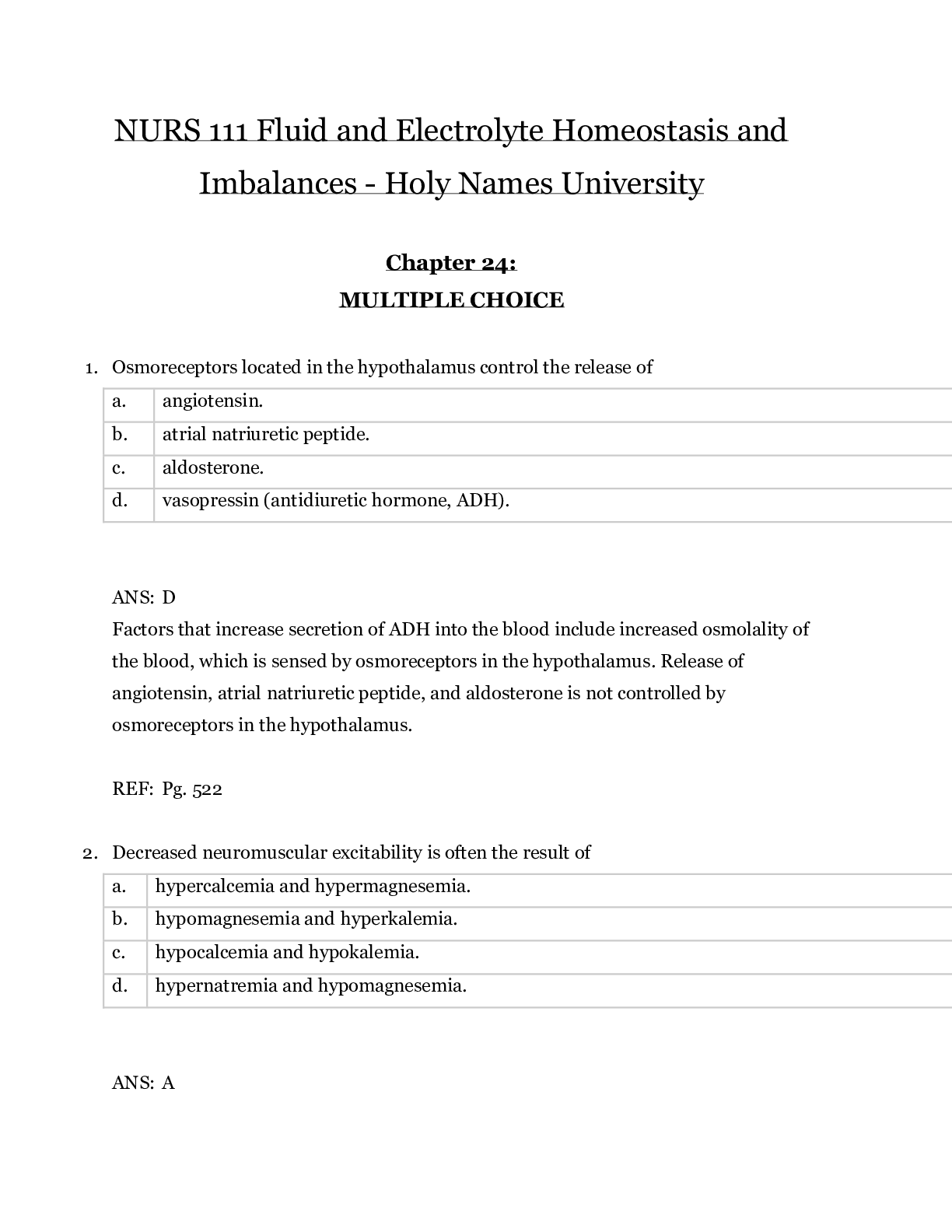
Instant download
Reviews( 0 )
Document information
Connected school, study & course
About the document
Uploaded On
Jan 23, 2021
Number of pages
27
Written in
Additional information
This document has been written for:
Uploaded
Jan 23, 2021
Downloads
0
Views
68














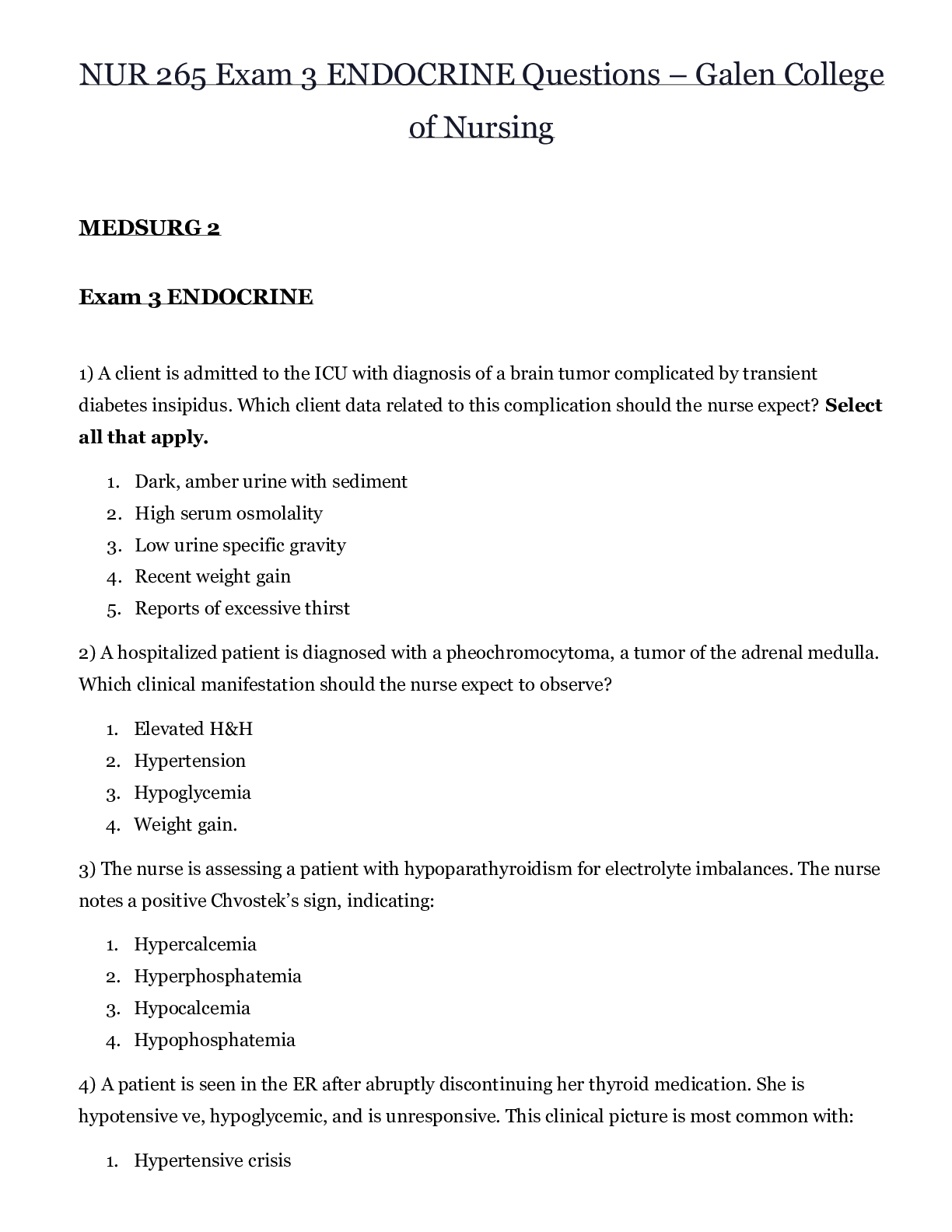
 – CHAMBERLAIN COLLEGE OF NURSING.png)
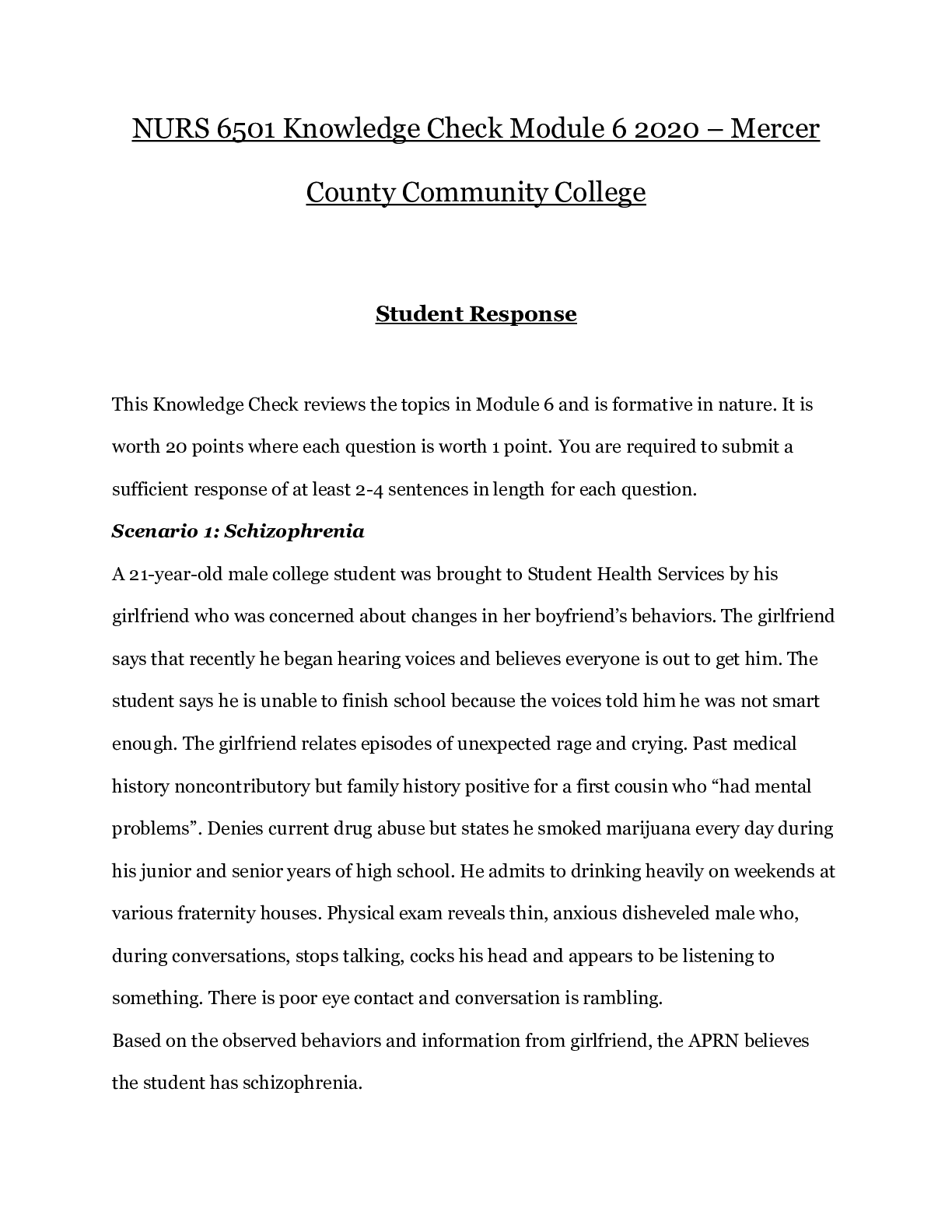


.png)
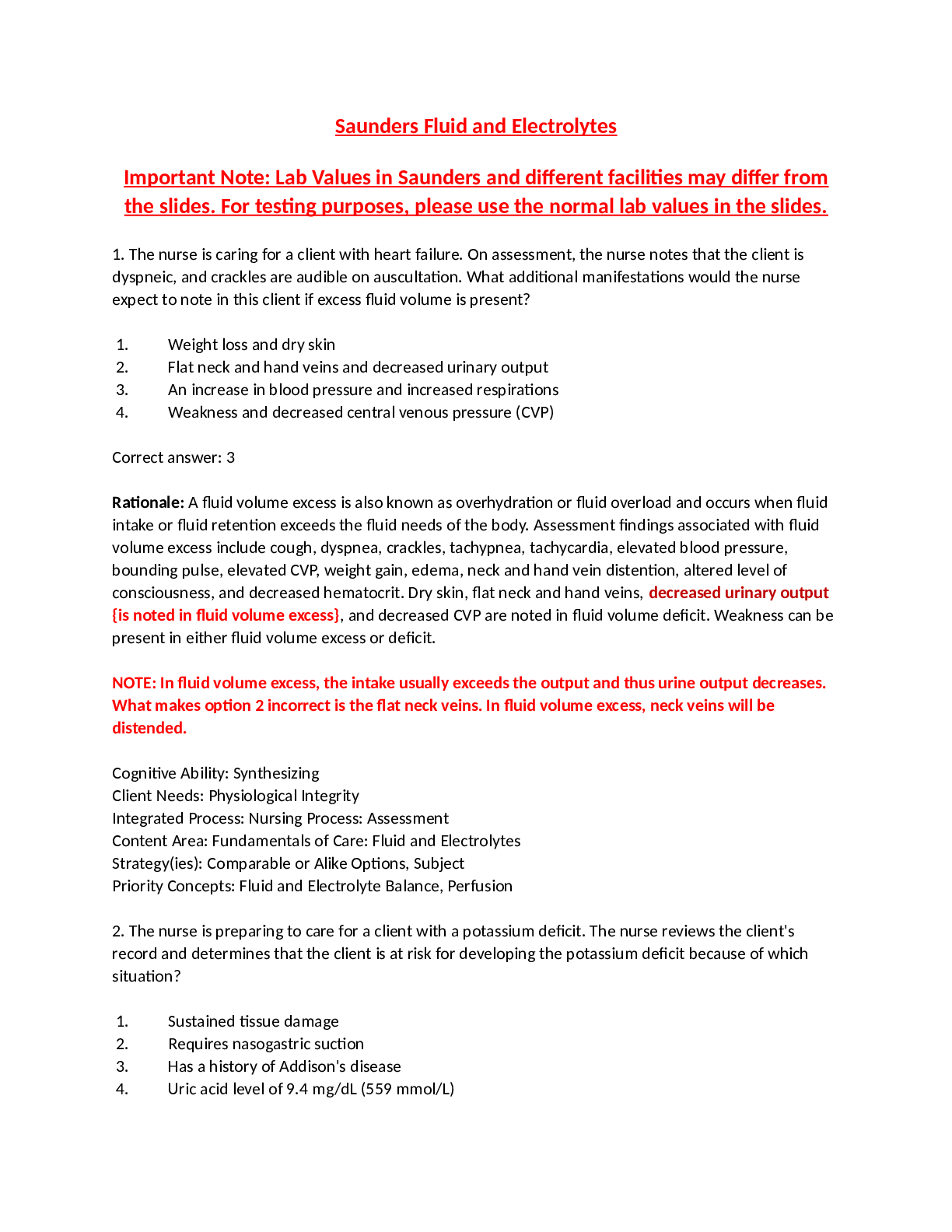
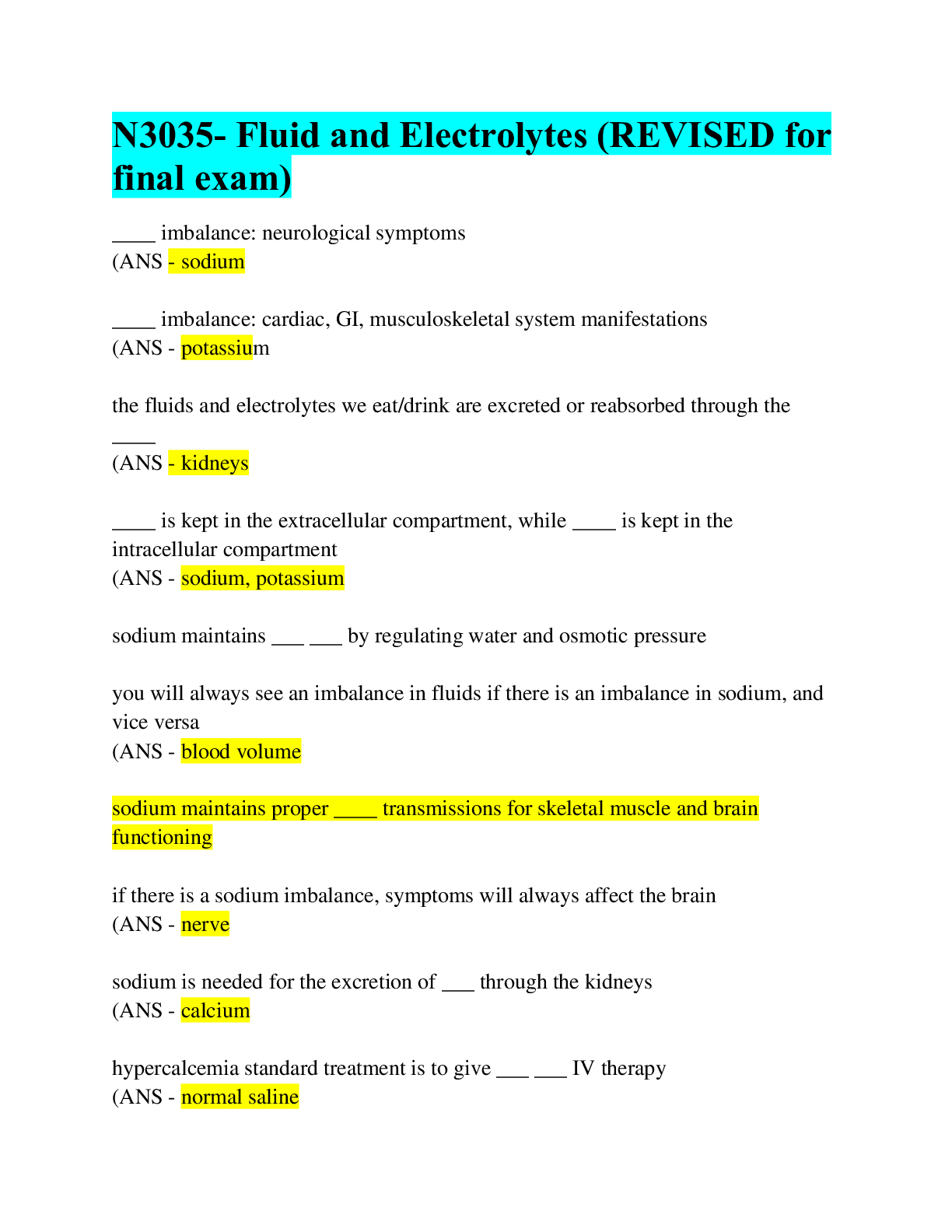
.png)

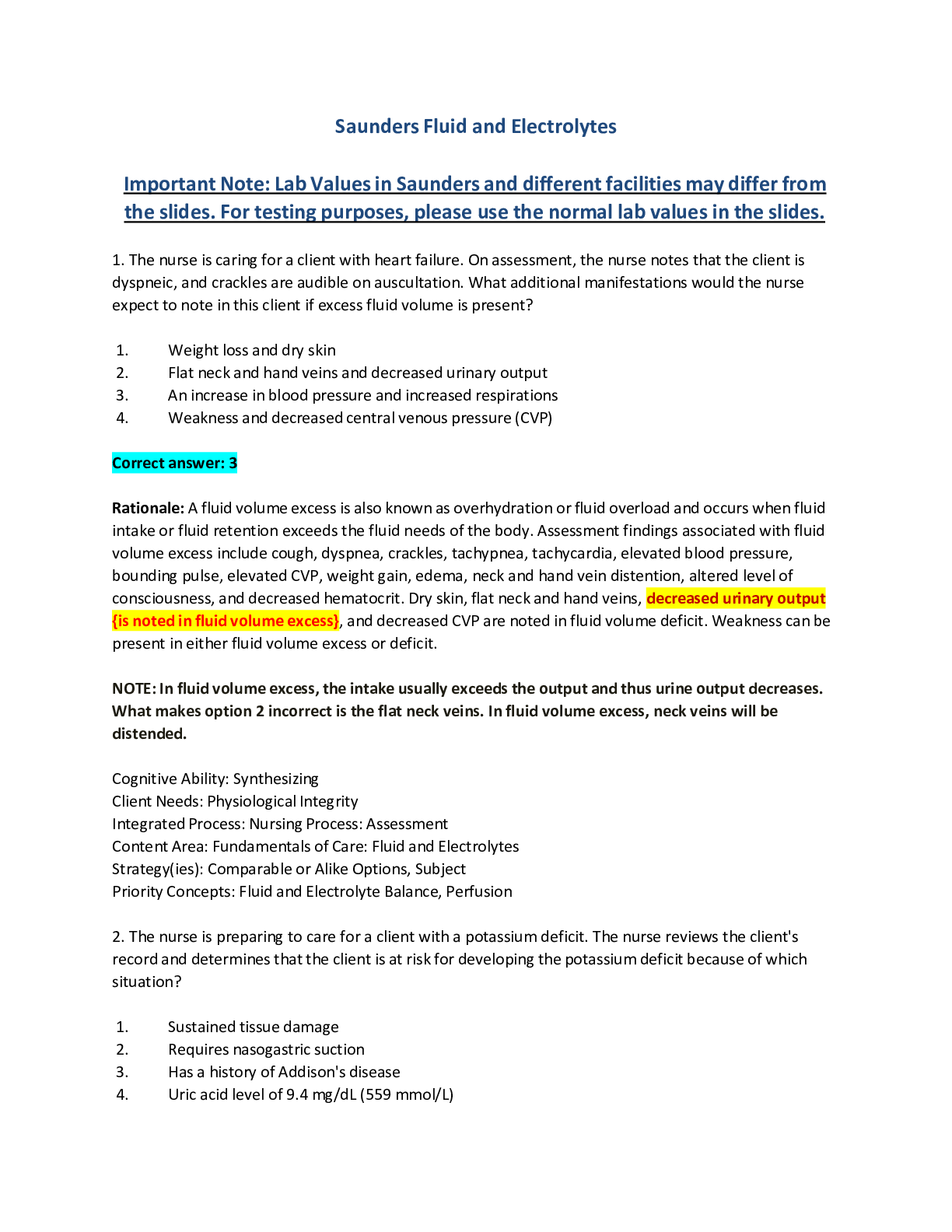

.png)


.png)
.png)

